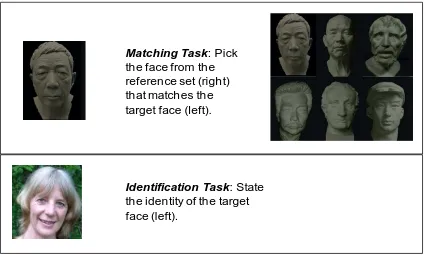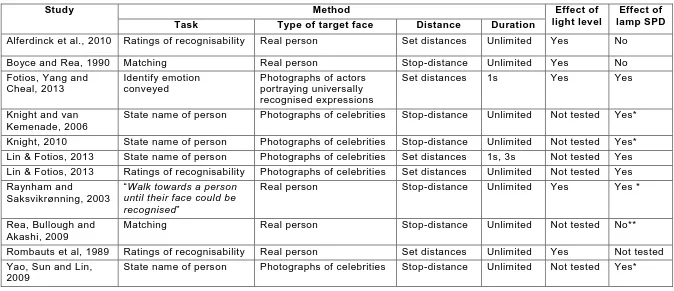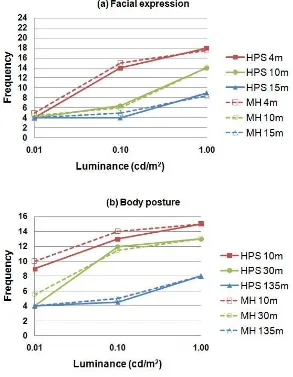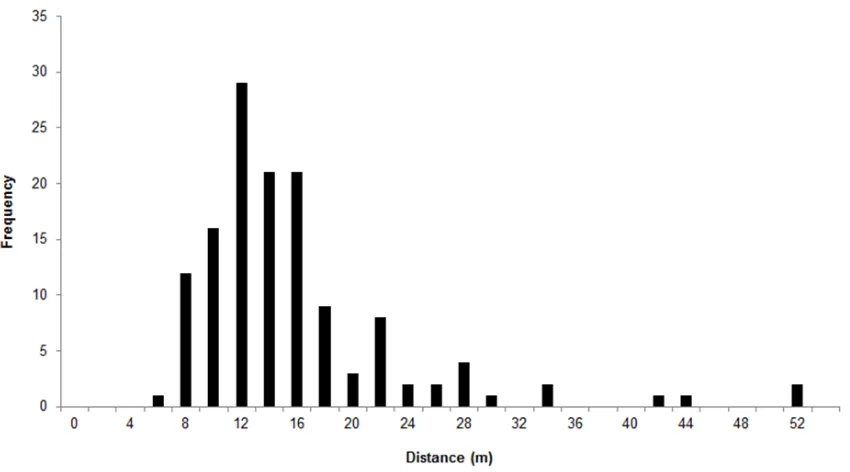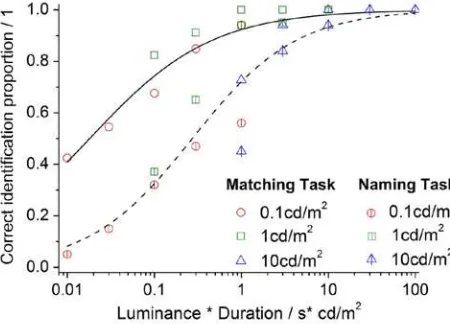This is a repository copy of Interpersonal judgements, lamp spectrum and task difficulty
.
White Rose Research Online URL for this paper:
http://eprints.whiterose.ac.uk/81138/
Version: Accepted Version
Proceedings Paper:
Fotios, S., Dong, M., Yang, B. et al. (1 more author) (2014) Interpersonal judgements,
lamp spectrum and task difficulty. In: Proceedings of CIE 2014 Lighting Quality & Energy
Efficiency. CIE 2014 Lighting Quality & Energy Efficiency, 23-26 April 2014, Kuala Lumpur,
Malaysia. , 357 - 366. ISBN 978-3-902842-49-7
eprints@whiterose.ac.uk https://eprints.whiterose.ac.uk/
Reuse
Unless indicated otherwise, fulltext items are protected by copyright with all rights reserved. The copyright exception in section 29 of the Copyright, Designs and Patents Act 1988 allows the making of a single copy solely for the purpose of non-commercial research or private study within the limits of fair dealing. The publisher or other rights-holder may allow further reproduction and re-use of this version - refer to the White Rose Research Online record for this item. Where records identify the publisher as the copyright holder, users can verify any specific terms of use on the publisher’s website.
Takedown
If you consider content in White Rose Research Online to be in breach of UK law, please notify us by
Fotios, Dong, Yang, Lin. INTERPERSONAL JUDGEMENTS, LAMP SPECTRUM AND TASK DIFFICULTY
INTERPERSONAL JUDGEMENTS, LAMP SPECTRUM AND TASK
DIFFICULTY
Steve Fotios1, Mengdi Dong2, Biao Yang1, Yandan Lin2 1
School of Architecture, University of Sheffield, Sheffield, UK 2
Institute for Electric Light Sources, Fudan University, Shanghai, China Correspondence author: ydlin@fudan.edu.cn
Abstract
The aim of this work is to identify optimum parameters for design of lighting for pedestrians to meet their needs for interpersonal judgements, including luminance and SPD. This paper discusses three factors that affect performance of a facial recognition task – the duration and distance of observation and the task carried out – as these factors affect the interpretation of the optimum luminance and whether or not the effect of lamp spectrum is significant. For SPD, it appears that this matters if the task is difficult (e.g. limited observation duration): a better SPD (for which the best parameter still needs to be defined) allows recognition at greater distances. For luminance, this might be defined by the knee in the plateau-escarpment relationship. A new study is presented that suggests a relationship between task difficulty and facial recognition probability where task difficulty is defined as the product of observation duration and luminance.
Keywords: Interpersonal judgement, facial recognition, lamp spectrum, task difficulty
1 Introduction
One basis for the provision of road lighting in residential areas is to enable interpersonal judgements about other people - whether another person is likely to be friendly, indifferent or aggressive, in time to make an appropriate response (Caminada & van Bommel 1980; Fotios and Goodman, 2012). Analysis of the visual fixations of pedestrians using eye-tracking provides confirmation that observation of other people is a critical task (Fotios et al, in press (a)). Good road lighting should enhance the ability to make such judgements. This paper discusses evidence as to whether the visual components of interpersonal judgements are affected by lamp spectrum (SPD).
Several studies have investigated lamp spectrum and facial recognition but these lead to mixed results, with some suggesting a significant effect (e.g. Knight, 2010) while others did not (e.g. Rea et al, 2009). These data were reviewed by Lin and Fotios (2013), who concluded that an effect of spectrum is expected when the task is difficult, e.g. when the task is small (i.e. a distant person), when it observed for only a short time (e.g. ≤1000 ms), when the face is unfamiliar and when vision is deteriorated by glare.
Many past studies have investigated lighting and facial recognition, but recognition is unlikely to be the only, nor most essential, task concerning other people (Fotios & Raynham, 2011). What may be more essential is the decision as to whether it is safe to approach another person or whether they should be avoided: Willis et al (2011) found that faces exhibiting angry expressions were less approachable than those with happy expressions, and similarly for emotions conveyed by body posture. Approachability was defined as the willingness to approach a stranger in a crowded street to ask for directions, which might be considered the polar opposite of a judgement of threat intent and the resulting motivation to avoid.
Fotios, Dong, Yang, Lin. INTERPERSONAL JUDGEMENTS, LAMP SPECTRUM AND TASK DIFFICULTY
2 Experimental Design
Table 1 presents a summary of the methods used in past studies. We suggest that several factors may affect task difficulty; task , duration and distance (visual size of target), in addition to luminance. There may also be an effect of glare as there is some evidence that face luminance required for pedestrian visibility increases as equivalent veiling luminance increases (Kohko et al, 2008) but that is not addressed in the current article.
2.1 Task
Two tasks that have been used in past facial recognition studies are identification (or, naming) and matching (Figure 1). The identification task requires test participants to state the name of the target person: of the tests listed in Table 1, all used photographs of celebrities. In the matching task, test participants are required to match the target person with one of a small sample of faces in a reference set.
Matching Task: Pick
the face from the
reference set (right)
that matches the
target face (left).
[image:3.595.86.512.246.501.2]Identification Task: State
the identity of the target
face (left).
Figure 1 – Illustration of the matching and identification facial recognition tasks.
In the two studies using a matching task, mean recognition distances ranged from 12 metres (Rea et al, 2009) to 24.9 metres (Boyce & Rea, 1990). Neither of these suggested the effect of SPD to be significant. In three studies using an identification task mean recognition distances were in the range of 5.4 metres to 8.45 metres (Knight & van Kemenade, 2006; Yao et al, 2009; Knight, 2010): the target needed to be closer (i.e. of a larger visual size) to permit correct identification than found in the matching task, suggesting identification to be the more difficult task. Identification requires recollection of the name of a celebrity: whilst they need to be well-known, they appear unexpectedly. One reason that the matching task is easier is that prior inspection of the reference set raises familiarity with the faces. There is some evidence for this in the study by Persike et al (2013) who found that familiar faces were found more quickly than unfamiliar faces in a search task.
Fotios, Dong, Yang, Lin. INTERPERSONAL JUDGEMENTS, LAMP SPECTRUM AND TASK DIFFICULTY
Table 1 – Methods used in past studies of inter-personal judgements
Note: (i) Matching = match target face with one from a samples of reference faces. (ii) Stop distance: this requires the test participant to walk toward the target except for Boyce & Rea 1990 where the target walked towards the test participant. (iii) * In these studies there was a trend for SPD to affect recognition distance but there is no statistical analysis of differences.
Study Method Effect of
light level
Effect of lamp SPD Task Type of target face Distance Duration
Alferdinck et al., 2010 Ratings of recognisability Real person Set distances Unlimited Yes No
Boyce and Rea, 1990 Matching Real person Stop-distance Unlimited Yes No
Fotios, Yang and Cheal, 2013
Identify emotion conveyed
Photographs of actors portraying universally recognised expressions
Set distances 1s Yes Yes
Knight and van Kemenade, 2006
State name of person Photographs of celebrities Stop-distance Unlimited Not tested Yes*
Knight, 2010 State name of person Photographs of celebrities Stop-distance Unlimited Not tested Yes* Lin & Fotios, 2013 State name of person Photographs of celebrities Set distances 1s, 3s Not tested Yes Lin & Fotios, 2013 Ratings of recognisability Photographs of celebrities Set distances Unlimited Not tested Yes Raynham and
Saksvikrønning, 2003
“Walk towards a person
until their face could be recognised”
Real person Stop-distance Unlimited Yes Yes *
Rea, Bullough and Akashi, 2009
Matching Real person Stop-distance Unlimited Not tested No**
Rombauts et al, 1989 Ratings of recognisability Real person Set distances Unlimited Yes Not tested Yao, Sun and Lin,
2009
Author(s) TITLE {see INSTRUCTIONS FOR THE PREPARATION OF PAPERS FOR CIE PROCEEDINGS}
An alternative task is to use ratings of recognisability (Alferdinck et al, 2010; Rombauts et al, 1989) in which the participant is instructed to make an assessment of the recognition of the face of a target person along a bipolar rating scale (e.g. absolutely not recognisable to
completely recognisable). An advantage of this approach is that real people can be used as
targets, there being no need for celebrity faces as identification is not required. Disadvantages are that ratings of recognisability are an unknown dimension, we do not know how respondents use the scale, and this may lead to a large variance.
Fotios, Yang and Cheal (2013) sought evaluations of the emotion conveyed by facial expressions. For faces there are six universally recognised expressions: anger, disgust, fear, happiness, neutrality and sadness (Etcoff & Magee, 1992). Initially, they sought a direct response as to whether the person was considered to be a threat, but these results were not found to be consistent (Fotios & Yang, 2013). Hence, instead they sought identification of the emotion conveyed.
2.2 Duration of observation
The majority of studies in Table 1 allowed an unlimited period of observation for the evaluation. Table 2 shows the results of facial recognition tasks carried out for observation durations of 0.1, 0.3, 1.0, 3.0 and 10.0 seconds using matching and identification tasks (see below). Differences between the three longer durations (1.0, 3.0 and 10 s) do not appear to be significant: performance with the two shorter durations are different from each other and from the longer durations. Observation duration matters.
Table 2 – Proportion of correctly identified faces using matching and identification tasks for different observation durations (see below). These data are for the luminance of 0.1 cd/m2.
Task Proportion of correct identification according to observation duration (s)
0.1 0.3 1 3 10
Identification 0.05 0.15 0.32 0.47 0.56
Matching 0.42 0.55 0.68 0.85 0.94
Lin and Fotios (2013) repeated an identification task using two durations of observation, 1000ms and 3000ms. The mean distances at which correct identification of identity was first found was slightly longer under 3 s observing duration than 1 s, suggesting the identification task was more difficult with the shorter exposure time. In the 1000 ms trials there was an effect of SPD, with significantly better task performance under Metal Halide lighting than under LED or HPS lighting. At 3000 ms, the results did not suggest an effect of SPD. Thus, the observation duration permitted in an experiment influences whether the an effect of SPD is likely to be revealed.
Unlimited observation is not a realistic pedestrian experience. An estimate of the typical time for which other people are centrally fixated was established by measuring fixation time in the records of an eye tracking study (Fotios et al, in press (a)) and this suggested a median fixation duration on other pedestrians of approximately 500 ms. Confirmation of this is found in the study by Jovancevic-Misic and Hayhoe (2009): the first of their 48 laps of the oval laboratory path best simulated real situations, i.e. before learning of the behaviour patterns of target pedestrians had been gained, and for these laps the fixation duration was also approximately 500 ms.
2.3 Distance
Past studies have used either a stop-distance method, or have sought judgements at one or more fixed distances: neither approach considers the needs of pedestrians.
Author(s) TITLE {see INSTRUCTIONS FOR THE PREPARATION OF PAPERS FOR CIE PROCEEDINGS}
walking following recognition requires a change in gait. The stop-distance method is subject to large errors because different targets and observers walk at different speeds and different observes take different amounts of time to make up their mind. Lighting characteristics can affect gait (Figueiro et al, 2011). Consequently, any delay in deciding that a face has been recognised can have different consequences. A step towards overcoming this is to enforce walking of a constant, slow velocity (Hayduk, 1978) but this does not appear to have been done in past facial recognition studies.
Recognition judgements can also be sought at a series of fixed distances, from which to interpolate lighting characteristics for a given decision criterion. While this was done in two studies (Alferdinck et al, 2010; Lin & Fotios, 2013) it introduced further complications: in both studies judgements were sought initially at the greatest distance with further judgements at progressively shorter distances. Instead, distances should have been experienced in a random order to offset learning effects, this exaggerated in one study (Alferdinck et al, 2010) by repeated observation of the same target. An alternative approach, when using images as targets rather than real faces, is to employ a constant observation distance but vary the size of the photograph to simulate different interpersonal distances.
From past experiments we learn the distance at which a particular task was achieved. What the results do not tell us is the distance at which interpersonal evaluations are desired by pedestrians. This distance is important as it is likely to affect estimates of the optimum luminance needed for task performance and whether or not there is a significant effect of lamp SPD.
The implication of distance can be seen in the results of the experiment by Fotios et al (2013) who sought the emotion conveyed by facial expression and body posture under three luminances, two SPD, with three interpersonal distances simulated by target size. For a 4 m distant target the optimum luminance for facial expression (as defined by transition in the plateau-escarpment relationship) was approximately 0.1 cd/m2, while for the 10 m target it would increase to over 1.0 cd/m2 (Figure 2) Their evaluations of body posture suggested an effect of SPD on emotion recognition for those cases are those in the middle of the luminance and distance combinations - when the task was either relatively difficult (i.e. small size and low luminance) or easy (i.e. large size and high luminance) then lamp type did not affect the task.
An understanding of the distance at which interpersonal judgements are desirable would be useful to inform interpretation of the optimum characteristics of lighting. Caminada and van Bommel (1980) suggested a requirement to recognise the face of an approaching pedestrian at a distance of 4 m, this apparently rounded from the border between the social and public zones of personal space proposed by Hall (1969). Alternative classification of personal space was reported by Cutting and Vishton (1995) who suggested three zones: personal space (up to 2 m), action space (2 m to 30 m) and vista space (>30 m). The Cutting and Vishton (1995) data are presented here to demonstrate that Hall’s proposals are not definitive, and that awareness of other classifications of personal space may have lead Caminada and van Bommel towards an alternative minimum distance.
While two laboratory studies (Adams and Zuckerman, 1991; Fujiyama et al, 2005) have attempted to measure interpersonal comfort distances we do not consider the data to be credible. The results from Fujiyama et al suggest comfortable interpersonal distances that are longer (4.0 to 5.2 m) than do the results from Adams and Zuckerman (0.53 to 1.2 m):this is probably a stimulus range bias – the laboratory of larger physical size led to the larger estimate of comfort distance. Further concern is that in laboratory studies the test participants know they are being observed (Sundstrom and Altman, 1976) and are not subject to the effects of reassurance (Fotios et al, in press (b)).
Author(s) TITLE {see INSTRUCTIONS FOR THE PREPARATION OF PAPERS FOR CIE PROCEEDINGS}
[image:7.595.154.447.168.545.2](73.3%) were fixated at least once. Figure 3 shows the median distance at which other pedestrians were fixated, this being the median across the 40 test participants for each of the four combinations of two route sections and two times of day (daytime and after-dark). These data suggest a tendency to fixate upon other pedestrians in the range of approximately 6 m to 16m, with a mode of 10-12 m, and extreme values of up to 52 m.
Figure 2 – Median frequencies for correct identification of emotion from facial expression (a) and body posture (b) (Fotios et al, 2013). The legends show lamp type (MH or HPS lamp) and
simulated target distance.
3 Experiment to investigate difficulty
Author(s) TITLE {see INSTRUCTIONS FOR THE PREPARATION OF PAPERS FOR CIE PROCEEDINGS}
Figure 3 –Median frequency of distances at which other people were fixated whilst walking outdoors. These data are for 40 test participants, walking two route sections in daytime and after-dark (hence n=160). Note: the x-axis label of ‘8’ (for example) represents the upper limit of
distance, i.e. a bin 6<x≤8 m.
Targets were photographs presented on a display screen. For the matching task these were black and white photographs of 16 sculptures of heads. For each trial eight target faces, chosen at random, were shown on one screen in a random order. A second screen permanently displayed 10 reference faces, these including 7 of the 8 target faces and three others. For the identification task, the targets were 15 colour photographs of the faces of well-known stars in China, one photograph for each test condition, chosen from a set of 26, including the including four males and four females as were used in a previous study (Lin & Fotios, 2013). For the identification task there were no reference images.
The targets were displayed on a self-luminous screen (EIZO Color Edge CG241W, 24.1 inch display), observed from a distance of 4.5 m with the test participant’s eye position fixed using a chin rest. The target images were approximately 90 mm in height, and at the 4.5 m observation distance this simulates a distance of approximately 10 m assuming a typical face height of 200 mm. The digital display allowed accurate control of observation duration and screen brightness rather than ambient light was used to vary target luminance. The matching and identification tasks were carried out separately, with test participant samples of 38 and 20 respectively. Each test participant carried out 15 trials, one for each combination of luminance and duration, and these were observed in a randomised order.
Author(s) TITLE {see INSTRUCTIONS FOR THE PREPARATION OF PAPERS FOR CIE PROCEEDINGS}
Table 3 – Proportion of correct facial recognition achieved using matching and identification tasks under 15 combinations of luminance and observation duration.
Luminance
(cd/m2) Proportion correct identification Observation duration (s)
0.1 0.3 1 3 10
Matching task
0.1 0.42 0.55 0.68 0.85 0.94
1 0.82 0.91 1.00 1.00 1.00
10 0.73 0.94 1.00 1.00 1.00
Identification task
0.1 0.05 0.15 0.32 0.47 0.56
1 0.37 0.65 0.94 0.95 1.0
10 0.45 0.84 0.94 1.0 1.0
These data show clearly that the facial recognition taskis affected by both luminance and duration. Consider that task difficulty is represented by the product of luminance and duration (L*D). Figure 4 shows the relationship between the identification proportion and the logarithmic scale of L*D for the matching and identification tasks. The best fit lines, determined using a logistic fit, indicates that the product of luminance and duration provides a good model for task performance (matching: R2 = 0.86, naming: R2=0.87, n=15 for both).
Interpolation of Figure 4 permits estimates of optimum luminance to be made. First, assume that the minimum probability of correct identification is set at 0.85, an estimate which requires substantiation. The matching task and naming task require L*D values of 0.3 and 3.0 respectively. For the typical observation duration of 500 ms, these represent optimum luminances of 0.6 cd/m2 for the matching task and 6 cd/m2 for the naming task.
Figure 4 – Relationship between correct identification proportion and product of target luminance and observation duration for results of the matching and identification (naming)
tests carried out using targets at an equivalent distance of 10 m.
4 Conclusion
[image:9.595.181.406.429.591.2]Author(s) TITLE {see INSTRUCTIONS FOR THE PREPARATION OF PAPERS FOR CIE PROCEEDINGS}
size; brief observation duration; lower luminance; unfamiliar face) a better SPD allows better recognition ability.
The aim of this work is to identify optimum parameters for design of lighting for pedestrians, from the need of interpersonal judgements, including luminance and SPD. To achieve this, it seems necessary to identify the observation distance and observation duration previously. From the past experiments, we can get some evidence that pedestrians tend to observe others at a distance in the region of 15m and with a duration of 500ms. For the factor of specific task, it was alternative. On the premise of these values, the optimum luminance for a particular correct recognition probability can be suggested according to Figure 4, resulting in 0.6cd/m2 for the matching task and 6 cd/m2 for the naming task.
Acknowledgement The Sheffield contribution to this work was carried out through support from EPSRC (EP/H050817) as part of the MERLIN project.
References
ADAMS, L. & ZUCKERMAN, D. 1991. The Effect of Lighting Conditions on Personal Space Requirements. The Journal of General Psychology, 118, 335-340.
ALFERDINCK, J., HOGERVORST, M., VAN EIJK, A. & KUSMIERCZYK, J. 2010. Mesopic vision and public lighting – A literature review and a face recognition experiment. Soesterberg: TNO Defensie en Veiligheid.
BOYCE, P. & REA, M. 1990. Security lighting: Effects of illuminance and light source on the capabilities of guards and intruders? Lighting Research and Technology, 22, 57-79.
BRITISH STANDARDS INSTITUTION (BSI) BS 5489-1: 2003. Code of practice for the design of road lighting - Part 1: Lighting of roads and public amenity areas. London: BSI.
BULLIMORE, M., BAILEY, I. & WACKER, R. 1991. Face recognition in age-related maculopathy. Investigative Ophthalmology & Visual Science, 32, 2020-2029.
CAMINADA, J. & VAN BOMMEL, W. 1980. New lighting considerations for residential areas.
International Lighting Review, 31, 69-75.
CUTTING, J. & VISHTON, P. 1995. Perceiving layout and knowing distances: The integration, relative potency, and contextual use of different information about depth. In: EPSTEIN, W. & ROGERS, S. (eds.) Perception of space and motion. London: Academic Press.
ETCOFF, N. L. & MAGEE, J. J. 1992. Categorical perception of facial expressions. Cognition, 44, 227-240.
FIGUEIRO, M., PLITNICK, B., REA, M., GRAS, L. & REA, M. 2011. Lighting and perceptual cues: Effects on gait measures of older adults at high and low risk for falls. BMC Geriatrics, 11, 49.
FOTIOS, S. & GOODMAN, T. 2012. Proposed UK guidance for lighting in residential roads.
Lighting Research and Technology, 44, 69-83.
FOTIOS, S. & RAYNHAM, P. 2011. Correspondence: Lighting for pedestrians: Is facial recognition what matters? Lighting Research and Technology, 43, 129-130.
Author(s) TITLE {see INSTRUCTIONS FOR THE PREPARATION OF PAPERS FOR CIE PROCEEDINGS}
FOTIOS, S., UTTLEY J., CHEAL C., HARA N. (In press (a)). Using eye-tracking to identify pedestrians’ critical visual tasks. Part 1. Dual task approach. Lighting Research & Technology.
FOTIOS, S. & YANG, B. Exploring Interpersonal Judgements between Pedestrians. 7th Lux Pacifica, 6-8 March 2013 Bangkok, Thailand. 248-251.
FOTIOS, S., YANG, B. & CHEAL, C. 2013. Effects of outdoor lighting on judgements of emotion and gaze direction. Lighting Research and Technology, published online as DOI: 10.1177/1477153513510311
FUJIYAMA, T., CHILDS, C., BOAMPOMG, D. & TYLER, N. 2005. Investigation of Lighting Levels for Pedestrians-Some questions about lighting levels of current lighting standards. London: Centre for Transport Studies, UCL.
HALL, E. T. 1969. The Hidden Dimension, New York, Anchor Books. 123-124.
HAYDUK, L. A. 1978. Personal space: An evaluative and orienting overview. Psychological
Bulletin, 85, 117-134.
JOVANCEVIC-MISIC, J. & HAYHOE, M. 2009. Adaptive gaze control in natural environments.
The Journal of Neuroscience, 29, 6234-6238.
KNIGHT, C. 2010. Field surveys of the effect of lamp spectrum on the perception of safety and comfort at night. Lighting Research and Technology, 42, 313-329.
KNIGHT, C., VAN KEMENADE, J. & DEVECI, Z. 2007. Effect of outdoor lighting on perception and appreciation of end-users. 18th Biennial TRB Visibility Symposium, Berne, Switzerland. Transportation Research Board.
KOHKO, S., KAWAKAMI, K. & NAKAMURA, Y. 2008. A study on effects of veiling luminance on pedestrian visibility. Journal of Light & Visual Environment, 32, 315-321.
LIN, Y. & FOTIOS, S. 2013. Investigating methods for measuring facial recognition under lamps of different spectral power distribution. Lighting Research and Technology, published online as DOI: 10.1177/1477153513505306
RAYNHAM, P. & SAKSVIKRONNING, T. 2003. White light and facial recognition. The Lighting
Journal, 68, 29-33.
REA, M., BULLOUGH, J. & AKASHI, Y. 2009. Several views of metal halide and high-pressure sodium lighting for outdoor applications. Lighting Research and Technology, 41, 297-320.
ROMBAUTS, P., VANDEWYNGAERDE, H. & MAGGETTO, G. 1989. Minimum semicylindrical illuminance and modelling in residential area lighting. Lighting Research and Technology, 21, 49-55.
SUNDSTROM, E. & ALTMAN, I. 1976. Interpersonal relationships and personal space: Research review and theoretical model. Human Ecology, 4, 47-67.
TOWNSHEND, T. 1997. Safer City Centres: The Role of Public Lighting. In: OC, T. & TIESDELL, S. A. (eds.) Safer city centres: Reviving the public realm. London: Paul Chapman Publishing Ltd.
WILLIS, M., PALERMO, R. & BURKE, D. 2011. Judging approachability on the face of it: the influence of face and body expressions on the perception of approachability. Emotion, 11, 514-23.
